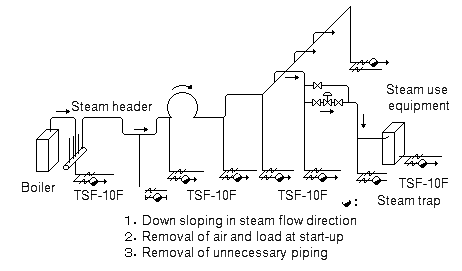Steam Transportation : Layout of Steam Transportation Piping
When considering the layout of steam transport pipe in view of condensate removal, it is important to make down sloping of 1/200 - 1/300 in steam flow direction for the transport piping.
If using inverse sloping, condensate against steam flow direction becomes difficult to flow.
When piping distance is long, once make the pipe rise to a high position on the way, and make the down sloping.
When starting up steam transport piping to work, inside of the pipe is filled with air.
This air has to be removed.
In addition, since the inside of the pipe is in ambient air temperature, a lot of steam is consumed to raise the temperature to steam temperature, and much more condensate generates compared with during normal operation.
However, condensate cannot be discharged if air is not removed firstly.
In this case, in order to avoid the complicatedness in manual operation of the bypass valve, it is necessary to install the automatic air vent and select the steam trap of good exhaust capability.
In the steam main, trap load in normal operation is usually small, about 10-20 kg/H.
Although the trap attached to the steam main is small capacity, in many cases, the number is the majority of traps in a factory.
Therefore, the trap is required, which has less steam leaks and does not cause failure.
The drip leg is required for condensate removal in steam main. In addition, to collect condensate positively, use a separator.
Although there are various separators, the one with the structure which revolves steam and separate condensate with centrifugal force is effective.
Condensate brought together in the bottom of the separator is discharged by steam trap.
It is important to attach a separator before steam equipment and to secure supply of dry saturated vapor.
In addition, in a factory, piping layout may often be changed and unnecessary piping may be left neglected.
In an extreme case, unnecessary piping is filled with steam and become a large steam loss.
Even if unnecessary piping is closed with stop valve, it is not secure since steam leak of the valve is expected.
It is required to remove unnecessary piping to close with blind flange.
Trap Installation for Steam Transport Piping
